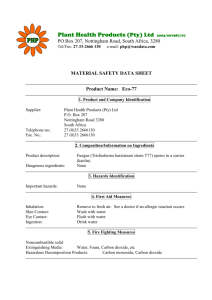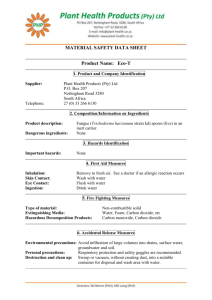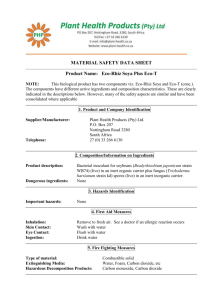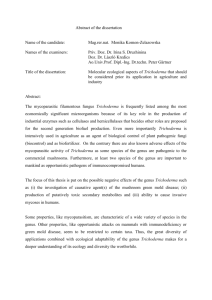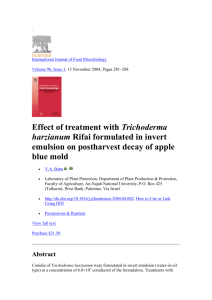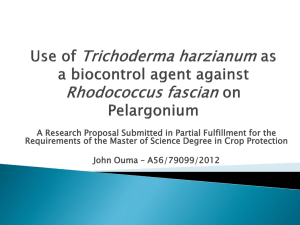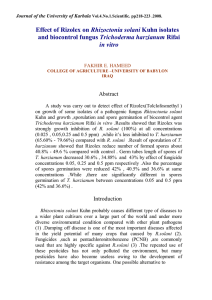Isolation of Trichoderma Spp. and Determination of Their
advertisement
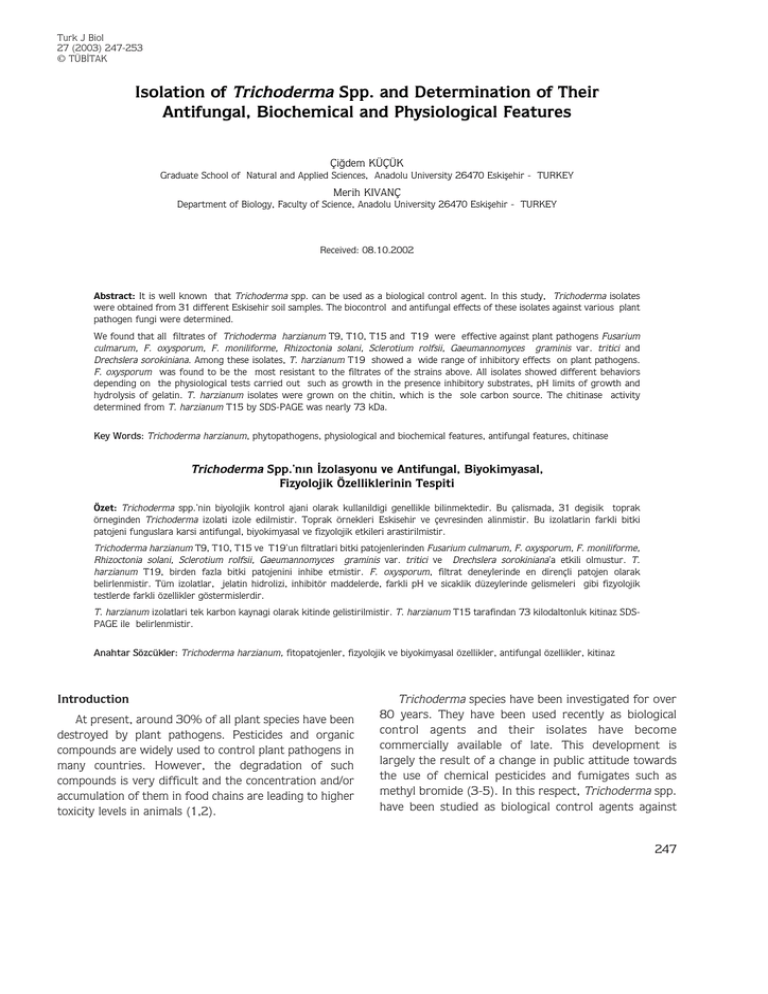
Turk J Biol 27 (2003) 247-253 © TÜB‹TAK Isolation of Trichoderma Spp. and Determination of Their Antifungal, Biochemical and Physiological Features Çi¤dem KÜÇÜK Graduate School of Natural and Applied Sciences, Anadolu University 26470 Eskiflehir - TURKEY Merih KIVANÇ Department of Biology, Faculty of Science, Anadolu University 26470 Eskiflehir - TURKEY Received: 08.10.2002 Abstract: It is well known that Trichoderma spp. can be used as a biological control agent. In this study, Trichoderma isolates were obtained from 31 different Eskisehir soil samples. The biocontrol and antifungal effects of these isolates against various plant pathogen fungi were determined. We found that all filtrates of Trichoderma harzianum T9, T10, T15 and T19 were effective against plant pathogens Fusarium culmarum, F. oxysporum, F. moniliforme, Rhizoctonia solani, Sclerotium rolfsii, Gaeumannomyces graminis var. tritici and Drechslera sorokiniana. Among these isolates, T. harzianum T19 showed a wide range of inhibitory effects on plant pathogens. F. oxysporum was found to be the most resistant to the filtrates of the strains above. All isolates showed different behaviors depending on the physiological tests carried out such as growth in the presence inhibitory substrates, pH limits of growth and hydrolysis of gelatin. T. harzianum isolates were grown on the chitin, which is the sole carbon source. The chitinase activity determined from T. harzianum T15 by SDS-PAGE was nearly 73 kDa. Key Words: Trichoderma harzianum, phytopathogens, physiological and biochemical features, antifungal features, chitinase Trichoderma Spp.’n›n ‹zolasyonu ve Antifungal, Biyokimyasal, Fizyolojik Özelliklerinin Tespiti Özet: Trichoderma spp.’nin biyolojik kontrol ajani olarak kullanildigi genellikle bilinmektedir. Bu çalismada, 31 degisik toprak örneginden Trichoderma izolati izole edilmistir. Toprak örnekleri Eskisehir ve çevresinden alinmistir. Bu izolatlarin farkli bitki patojeni funguslara karsi antifungal, biyokimyasal ve fizyolojik etkileri arastirilmistir. Trichoderma harzianum T9, T10, T15 ve T19’un filtratlari bitki patojenlerinden Fusarium culmarum, F. oxysporum, F. moniliforme, Rhizoctonia solani, Sclerotium rolfsii, Gaeumannomyces graminis var. tritici ve Drechslera sorokiniana’a etkili olmustur. T. harzianum T19, birden fazla bitki patojenini inhibe etmistir. F. oxysporum, filtrat deneylerinde en dirençli patojen olarak belirlenmistir. Tüm izolatlar, jelatin hidrolizi, inhibitör maddelerde, farkli pH ve sicaklik düzeylerinde gelismeleri gibi fizyolojik testlerde farkli özellikler göstermislerdir. T. harzianum izolatlari tek karbon kaynagi olarak kitinde gelistirilmistir. T. harzianum T15 tarafindan 73 kilodaltonluk kitinaz SDSPAGE ile belirlenmistir. Anahtar Sözcükler: Trichoderma harzianum, fitopatojenler, fizyolojik ve biyokimyasal özellikler, antifungal özellikler, kitinaz Introduction At present, around 30% of all plant species have been destroyed by plant pathogens. Pesticides and organic compounds are widely used to control plant pathogens in many countries. However, the degradation of such compounds is very difficult and the concentration and/or accumulation of them in food chains are leading to higher toxicity levels in animals (1,2). Trichoderma species have been investigated for over 80 years. They have been used recently as biological control agents and their isolates have become commercially available of late. This development is largely the result of a change in public attitude towards the use of chemical pesticides and fumigates such as methyl bromide (3-5). In this respect, Trichoderma spp. have been studied as biological control agents against 247 Isolation of Trichoderma Spp. and Determination of Their Antifungal, Biochemical and Physiological Features soil-borne plant pathogenic fungi (5-8). Results from different studies showed that several strains of Trichoderma had a significant reducing effect on plant diseases caused by pathogens such as Rhizoctonia solani, Sclerotium rolfsii, Phythium aphanidermatium, Fusarium oxysporum, F. culmorum and Gaeumannomyces graminis var. tritici under greenhouse and field conditions (4,5,8,9-12). Knowledge concerning the behaviour of these fungi as antagonists is essential for their effective use because they can act against pathogens in several ways (1,5). Isolates of Trichoderma harzianum can produce lytic enzymes (5,20) and antifungal antibiotics (13,15,19) and they can also be competitors of fungal pathogens (11), and promote plant growth (10). It was reported that the production of metabolites from different Trichoderma strains depends on ecological factors, and so the strains show varying effects on pathogens (6,21,22). Some of these metabolites have been isolated from sporulating or mycelial cultures but subcultivation decreased the production of the peptide antibiotics produced by Trichoderma isolates (2,17,18). T. harzianum is species aggregate, grouped on the basis of conidiophore branching patterns with short side branches short inflated phialides and smooth and small conidia (21). These characteristics allow for the relatively easy identification of Trichoderma as a genus, but the species concepts are difficult to interpret and there is considerable confusion over the application of specific names (21,22). This disparity of criteria makes it difficult to search for, and above all characterise, new biocontrol agents within the species and to reidentify them in a natural environment once they are present in a pathosystem (22). Such functions as ability of growth in a wide range of temperatures, capability of antagonising plant pathogens, using lignocellulosic materials for growth and both antibiosis and hyperparasitism make Trichoderma isolates a possible biocontrol agent (20,21,23). As a results, in this study we aimed to examine the antifungal effects, physiological features and biochemical effects of Trichoderma isolates isolated from different part of Eskisehir against some plant pathogen fungi. 248 Materials and Methods Isolation of Trichoderma spp. Thirty-one soil samples collected from different agricultural fields and forests in Eskisehir were inoculated onto potato dextrose agar (PDA, MERCK), malt extract agar (MEA; MERCK), rose bengal agar and oat flour agar and incubated at 28 ºC for 5 days. After an incubation period, colonies determined to be Trichoderma spp., according to Watts et al. (16) and Rifai (21), were purified. Plant pathogens Fusarium oxysporum, Rhizoctonia solani, R. cerealis, Gaeumannomyces graminis var. tritici and Sclerotium rolfsii were kindly donated by Faculty of Agriculture, Çukurova University, Adana. Fusarium moniliforme, F. culmorum and Drechslera sorokiniana were kindly provided by the Anadolu Agricultural Research Institution in Eskisehir. Determination of antifungal properties of culture filtrates of Trichoderma harzianum Each T. harzianum isolate was separately inoculated into 100 ml potato dextrose broth and incubated at 20 oC for 10 days. After incubation, the cultures were filtered through 0.22 mm millipore filters. The aliquats (2 ml) of these filtrates were placed in sterile petri dishes and 25 ml of 1/4 strength PDA at 45 ºC was added. After the agar solidified, mycelial discs of the pathogens (7 mm in diameter) obtained from actively growing colonies were placed gently in the centre of the agar plates. The petri dishes were incubated at 20 ºC for 6 days. Growth of the pathogens was recorded by measuring the diameter of the colonies each day. There were 3 replicates for each experiment (25). Inhibition of plant pathogen fungi on agar A piece of autoclaved sterile cellophane was placed on a 1/4 strength PDA plate in a petri dish and on the sheet, and a 7 mm diameter disc of selected T. harzianum isolates cultured on PDA was inoculated. Plates were incubated at 20 ºC for 6 days. After the incubation period, the cellophane was removed and each dish was separately inoculated in the centre with a plug (7 mm in diameter) of a mycelial disc of plant pathogens taken from actively growing colonies. Petri dishes were incubated at 20 ºC for a further 6 days. Percent age R I was calculated as follows: R I= 100 x (R2 - R1) / R2 (16), Ç. KÜÇÜK, M. KIVANÇ where R1 was the distance between the inoculum of the pathogen and the inoculum of the T. harzianum isolate, R2 was the colony growth of pathogen measured in the direction of maximum radius and RI was the mean value of 3 replicates per isolate (24). sodium nitrite; in liquid media nitrogen sources (2g l–1) i.e. sodium nitrite, ammonium oxalate, creatin and glycine (24, 25). All tests were done within 14 days (24,25). Determination of effect of volatile metabolites Aesculin hydrolysis, Starch hydrolysis, Tween 80 hydrolysis, cellulose [1,4-(1,3;1,4)-β-D-glucan-4glucanohydrolase] hydrolysis, hydrolysis of polypectate, casein hydrolysis, gelatin hydrolysis, reduction of tetrazolium were tested according to Grondona et al, Bridge and Lynch et al (24, 26). Petri dishes of 1/4 strength PDA were separately inoculated in the centre with a 7 mm diameter disc of pathogens and T. harzianum isolates. The petri dishes were incubated at 20 ºC for 6 days. The radial growth of the pathogens was measured daily. Physiological features of Trichoderma harzianum isolates Morphology: The clamydospore production and size of the conidia were examined under laboratory conditions. Morphological results are the mean values of at least 12 plates (25). Preparation of inocula: Each isolate to be tested was grown on Cz-agar (Chapek Dox Agar, Fluka) in petri dishes for 5 days. The spores were collected by washing from the petri dishes with 0.2% (v/v) aqueous Tween 80. The spores were washed twice in the Tween 80 solution by centrifugating and then were resuspended. This is equivalent to approximately 2 x 106 spore ml–1 (25). Growth at different temperatures: The ability to grow at 4, 37 and 40 ºC over 30 days was tested on Cz agar (25), and then the thermal resistance of the spore suspensions were recorded after a 5 min incubation at 75 ºC (24). Growth at different pH values: The ability to grow at pH 2, 10 and 12 was tested in liquid medium –1 containing 0.05 g l bromocresol purple (25). Assimilation of carbon sources: Growth and sporulation in liquid media containing glucose, ethanol, lactic acid, lactose, ammonium oxalate and citric acid as the sole carbon source, and aesculin and gelatin hydrolysis and an analysis of growth and colony texture in the presence of 0.005 or 0.001% crystal violet, and 0.05 or 0.001% copper sulphate were performed according to Bridge (25). Colony growth by 50, 100 and 200mg l–1 of copper sulphate was calculated according to Grondona et.al. (24). Assimilation of nitrogen sources: Growth and sporulation were obtained on solid media containing nitrogen sources (3g l–1) i.e. ammonium oxalate and T. Determination of enzyme activities of harzianum isolates Protein extraction and chitinolytic activity assay T. harzianum isolates were grown in synthetic medium (SM) containing 3 g of colloidal chitin as the sole carbon source (20). The protein concentration was determined using the method of Bradford (27). The protein extracts were prepared according to Harran et al (20). Electrophoresis Sodium dodecyl sulphate gel electophoresis (SDSPAGE) was used to determine molecular size (21, 28). For an accurate estimation of the molecular masses of T. harzianum isolates enzymes, proteins were separated by SDS-PAGE as above using a Bio-Rad protein electrophoresis cell in larger gels. The molecular masses of the chitilytic enzyme were estimated from the regression equation: log molecular mass of standard protein (Sigma) distance migrated (21). Results and Discussion Although none of the pathogens tested were sufficiently inhibited by filtrate of all T. harzianum isolates, filtrate of T. harzianum T19 was found to have a wide range of inhibitory effects against more than one plant pathogen fungi. R. solani and S. rolfsii were the most sensitive pathogen fungi to all T. harzianum isolates used. T. harzianum T19 provided a 100% inhibition rate for R. solani and the same results were also obtained for S. rolfsii with T. harzianum T3 and T19 isolates. Isolates of the Trichoderma spp. isolated from 31 different field and forest soils in Eskisehir were identified as T. harzianum Rifai (21). Other strains were found to be members of different species. It was reported that Trichoderma harzianum Rifai (21) is the most effective agent for the biocontrol of fungal pathogens (18). Rose 249 Isolation of Trichoderma Spp. and Determination of Their Antifungal, Biochemical and Physiological Features bengal and pentachloronitrobenzene (PCNB) were used together with captan as the basic antimicrobial agents for developing a semi-selective medium for the quantitative isolation of Trichoderma from the soils (3). F. oxysporum seemed to be the most resistant pathogen to all T. harzianum filtrates used in our experiments. Similarly, Watts et al. (16) reported that F. oxysporum was found to be the most resistant fungus tested. Ghisalberti and Sivasithamparam (18) suggested that modified metabolites might be produced by Trichoderma isolates in liquid cultures. Dunlop et al. (17) showed that an isolate of T. koningii inhibited the saprophytic growth of G. graminis (Sacc.) Arx and Oliver var. tritici Walker (Ggt). In our study we determined that nonvolatile metabolites produced by our selected isolates of T. harzianum had an inhibitory effect on the growth of the plant pathogenic fungi tested. Growth inhibition of the pathogens by the Trichoderma metabolites were reported in a considerable number of studies (13,14,18) and this phenomenon and related mechanisms have been explained by many authors (1,2,6,10,21,22). In this study, we observed that the volatile metabolites of T. harzianum isolates also have inhibitory effects on the growth of the plant pathogens tested. The most effective isolates were T. harzianum T10 and T19. While volatile metabolites of T. harzianum T10 inhibited the growth of D. sorokiniana, F. culmorum and R. cerealis, those of T. harzianum T15 inhibited the growth of F. culmorum, F. Moniliforme and G. graminis var. tritici. The other isolate of T. harzianum, T19, showed inhibitory effects on F. oxysporum, R. solani and S. rolfsii. A comparison between the inhibition effects of volatile and nonvolatile metabolites of our T. harzianum isolates revealed that the nonvolatile metabolites seemed to be more effective. In vitro, inhibition of the growth of 8 phytopathogenic fungi was worked out by confronting the T. harzianum isolates under these conditions. Marked inhibition of the growth of the 8 fungi occurred in the presence of most of the T. harzianum cultures studied. This assay showed variations in the percentage of inhibition of radial growth of the phytopathogen colonies by the different isolates of T. harzianum. The highest mean inhibition values, 88%RI, were obtained against S. rolfsii with T3 and against R. solani with T10 (Table 1). We observed that the plant pathogens of Fusarium spp. showed more resistance to the selected T. harzianum isolates than the other plant pathogen fungi examined (5). Whipps (11) stated that T. harzianum appears to be a promising organism, particularly for use against R. solani. However, none of the pathogens tested by Whipps (11) was inhibited by antagonists. Moreover, in the same study, he also reported that all pathogens were consistently inhibited by the previous growth of antagonists on PDA and Gliocladium roseum always provided 100% inhibition on this medium. A similar result was also obtained for G. graminis var. tritici. It was concluded that all of the isolates of Trichoderma produced metabolite(s) that diffused through the dialysis membrane and subsequently inhibited the growth of G. Table 1. Inhibition effects of T. harzianum on some phytopathogenic fungi. %RIa by Trichoderma harzianum isolates Phytopathogens T3 T7 T9 T10 Fusarium oxysporum 42 ± 0.04 38.8 ± 0.20 60 ± 0.43 Rhizoctonia solani 50 ± 0.00 74 ± 0.40 77 ± 0.20 Rhizoctonia cerealis T15 T19 T21 47.4 ± 0.10 62 ± 0.20 39.6 ± 0.30 38 ± 0.10 88 ± 0.20 56.7 ± 0.20 76.6 ± 0.30 82 ± 0.10 52 ± 0.40 53.4 ±0.40 51.2 ± 0.20 54.4 ± 0.10 57.8 ± 0.10 54 ± 0.40 58 ± 0.20 Gaeumannomyces graminis var.tritici 63.2 ± 0.10 33 ± 0.20 42.4 ± 0.20 47 ± 0.10 46.6 ± 0.00 28 ± 0.50 33 ± 0.70 Sclerotium rolfsii 88.8 ± 0.20 76 ± 0.00 86 ± 0.30 70.4 ± 0.10 42.7 ± 0.30 82.8 ± 0.30 75 ± 0.30 Fusarium moniliforme 46 ± 0.00 42 ± 0.10 53.4 ± 0.20 54.6 ± 0.30 46.6 ± 0.20 28 ± 0.00 37 ± 0.00 Fusarium culmorum 45 ± 0.10 44.4 ± 0.00 44.6 ± 0.00 50 ± 0.30 42.7 ± 0.40 34 ± 0.10 44 ± 0.60 Drechslera sorokiniana 40 ± 0.11 57.4 ± 0.30 47.6 ± 0.30 56.4 ± 0.20 48 ± 0.00 50 ± 0.70 40 ± 0.40 RIa : Range inhibition 250 Ç. KÜÇÜK, M. KIVANÇ graminis var. tritici (11). Dunlop et al. (17) indicated that the compound produced in agar culture by T. koningii inhibited the growth of several soil borne pathogens, namely; G. graminis var. tritici, R. solani, Phytophathora cinnamomi, Phythium middletonii, F. oxysporum and Bipolaris sorokiniana. Morphological characters were generally found to be highly variable, making them unreliable for species determination. In this work for isolates T19 and T21 the dimensions of the clamydospores were 7 and 11.2 mm respectively. Other isolates were found to have different diameters for the conidia. Rifai (21) distinguished 9 species aggregates based on microscopic characters. An important aspect of sporulation, almost completely disregarded in recent years has been the ability of Trichoderma spp. to produce clamydospores (22). Recently several studies have reported their formation and potential role in biocontrol (1,4,5). All isolates produced colonies larger than 8 cm in diameter on MEA, but they did not develop any ariel mycelial on Czapek dox agar and T9, T10, T15 and T19 developed yellow on MEA. It was observed that T. harzianum strains showed different growths at different temperatures but they did not grow on the media at pH 2, 10 and 12 (Table 2). Papavizas (22) found that pH values higher than 6.5 were needed for the maximal linear growth of T. harzianum. In liquid medium containing different carbon sources, T. harzianum isolates caused colour changes. We recorded that the T10 isolate in the medium containing citric acid, all of the isolates in the medium containing ethanol and the T9, T10 and T19 isolates in the medium Table 2. Some physiological properties of T. harzianum isolates. Isolates Characteristic T3 T7 T9 T10 T15 T19 T21 Production of chlamydospores - - + - - - + Conidial diameter of >2 µm + + + + + + + Growth on glucose + + + + + + + Growth on citric acid + + + + + + + Sporulation on citric acid + + + + + - - Purple coloration on citric acid - - - + - - - Sporulation on ethanol + + + + + + + Growth on lactic acid + + + + + + + Sporulation on lactic acid + + + + + + + Purple coloration on lactic acid - - - - - - - Growth on ammonium oxalate + + + + + + + Sporulation on ammonium oxalate - + + + - + - Sporulation on urea + + + + + + + Sporulation on creatine - - - - - - - Hydrolysis of gelatin + - - + - + - Growth on nitrite agar + + + + + + + Sporulation on aesculin + + + + + + - Spore resistance to heating (75 ºC for 5min) + + + + + + - 4 ºC - - - - - - - 37 ºC + - + + + - - 40 ºC - - - - - - - pH 2 - - - - - - - pH 10 - - - - - - - pH 12 - - - - - - - 251 Isolation of Trichoderma Spp. and Determination of Their Antifungal, Biochemical and Physiological Features containing ammonium oxalate produced purple pigment. In the case of lactic acid, we did not observe any colour change in any isolate. Only the T19 isolate formed an orange pigmentation in the medium with glucose. The T3, T10 and T19 isolates formed an orange pigment, hydrolysed gelatin. None of the isolates grew in the solid medium containing ammonium oxalate and sodium nitrite. All isolates developed a red pigmentation in the liquid medium with glycine and urea (Table 2). By using aesculin to determine the b-glucosidase activity of the isolates, it was found that the T3, T9, T10, T15, T19 and T21 isolates produced mycelium and spores on the medium (Table 3). In the same experiments when copper sulphate was added, none of the T. harzianum isolates grew very well (24). In this study, we have demonstrated in the agar based assays of copper sulphate; that this salt accumulated on the edge of the petri dishes as shown by Grondona et al (24). Showing the different features in different nitrogen and carbon sources was also defined by Grondona et al. (24). Our isolates of T. harzianum produced different coloured pigments from those of other studies. In experiments on Tween 80 hydrolysis to eliminate esterase activities, all isolates developed, except T3 and T21, and inverted the medium’s colour to a blue-purple. All of the isolates, developed in the medium with cellulase (Table 3). In the study of Lynch et al. (26) it was shown that the development of isolates in the medium showed variations depending on enzyme activity. In order to determine protease and cellulase activity, we noted that all isolates hydrolysed gelatin. It was shown that Trichoderma produced cellulase, β-(1-3)-glucanase and chitinase enzymes and degraded the glucans in the walls of the plant pathogens (7,12,20,23). T. harzianum is a potential agent for the biocontrol of plant pathogens. When grown on chitin as the sole carbon source T. harzianum isolates produced chitinolytic proteins (20,21,23). In order to detect the chitinolytic activity of Trichoderma, the chitinolytic proteins of T. harzianum isolates, grown with chitin as a sole carbon source, were analysed by SDS-PAGE. The molecular size of the protein of T. harzianum T15 was calculated to be 73 kDa by SDS-PAGE. The molecular weights of these proteins ranged from 28 to 73 kDa. While T. harzianum T15 had the largest molecular size (73 kDa), the T. harzianum T3 isolate had the smallest molecular size (28 kDa). The similarity of these calculated molecular weights would suggest that this enzyme might be present (20). The molecular weights of the chitinolytic enzymes isolated from the T7, T9, T19 and T21 isolates of T. harzianum were 31, 32, 43 and 38 kDa respectively. De La Cruz et al. (23) reported the isolation with molecular weights of chitinases of 37 kDa and 33 kDa, which is similar to those found by us. These enzymes were needed for maximum efficiency against for the biological control of chitin-containing plant pathogenic fungi. In conclusion, many studies in the past have found the Trichoderma spp. to be potential biocontrol agents of several soil-borne plant pathogens (4,7,10). Küçük (5) showed that 2 of the isolates were superior to others in suppressing the disease. It was concluded that the T. Table 3. Enzyme activities of T. harzianum isolates. T. harzianum isolates Tests T3 252 T7 T9 T10 T15 T19 T21 Hydrolysis of aesculin + + + + + + + Hydrolysis of starch - + + + + + - Hydrolysis of Tween 80 + + + + + + + Hydrolysis of gelatin - + + + + + - Reduction of tellurium + - + + + - - Hydrolysis of cellulase + + + + + + + Hydrolysis of casein - + - + - + - Hydrolysis of polypectate + + + + + + + Growth of tetrazolium chloride + + + + + + + Ç. KÜÇÜK, M. KIVANÇ harzianum isolates showed an antagonistic effect on plant pathogenic fungi as well as on their biochemical and physiological features. Thus the isolate T15 could be used in certain biological control studies. Acknowledgements This study was supported by grants 13 and 991031 from the Anadolu University Research Fund (AUAF), Eskiflehir. References 1. 2. 3. 4. Chet I. Trichoderma Application, Mode of Action and Potential as a Biocontrol Agent of Soil-borne Plant Pathogenic Fungi. In: “Innovative Approaches to Plant Disease Control”, ed. Chet I., Wiley, New York, pp. 137-160. 1987. Lynch JM. Fungi as Atagonists. In: “New Directions in Biological Control: Alternatives for Suppressing Agricultural Pests and Diseases”, Liss, New York, pp. 243-253. 1990. Elad Y, Chet I, Katan Y. Trichoderma harzianum a biocontrol agent effective against Sclerotium rolfsii and Rhizoctonia solani. Phytopathology. 70: 119-121. 1980. Basim H., Öztürk SB, Yegen O. Effificacy of a biological fungiside (Planter Box (Trichoderma harzianum Rifai T-22)) against seedling root rot pathogens (Rhizoctonia solani, Fusarium sp.) of cotton. GAP-Environmental Symposium. fianl›urfa, Turkey. p.137-144. 1999 5. Küçük Ç. Trichoderma harzianum ile Toprak Kökenli Bazi Bitki Patojenlerinin Kontrolü. MSc. Thesis.Anadolu University. Eskisehir. 2000. 6. Henis Y. Biological control. In “Current Perspectives in Microbial Ecology”, eds. Klug, MJ, Reddy CA, American Society of Microbiology, Washington pp. 353-361. 1984. 7. Chet I, Baker R. Induction of suppressiveness to R. solani in soil. Phytopathology 70: 994-998. 1980. 8. Chet I, Inbar J. Biological Control of Fungal Pathogens. Applied Biochemistry and Biotechnology 48: 37-43. 1994. 9. Sivan A, Chet I. Integrated Control of Media on Growth and Interactions between a range of Soilborne Glasshouse Pathogens and Antagonistic Fungi. Phytopathology 10: 127-142. 1993. 10. Inbar J, Abramsky M, Cohen D, et al. Plant Growth Enhancement and Disease Control by Trichoderma harzianum in Vegetable Seedlings Grown under Commercial Conditions. European Journal of Plant Pathology 100: 337-346. 1994. 11. 12. 13. 14. Whipps JW. Effect of Media on Growth and Interactions between a Range of Soil-borne Glasshouse Pathogens and Antagonistic Fungi. New Phytol 107: 127-142. 1987. Chet I, Baker R. Isolation and biocontrol potential of Trichoderma hamatum from soil naturally suppressive to R. solani. Phytopathology 71: 286-290. 1981. Dennis C, Webster J. Antagonistic Properties of Species Groups of Trichoderma. I Production of non-volatile antibiotics. Trans Br Mycol Soc 57: 25-39. 1971. 15. Brewer D, Mason FG, Taylor A. The Production of Alamethicins by Trichoderma spp. Can J Microbiol 33: 619-625. 1987. 16. Watts R, Dahiya J, Chaudhary K, et al. Isolation and Characterization of a New Antifungal Metabolite of Trichoderma reseii. Plant and Soil 107: 81-84. 1988. 17. Dunlop RW, Simon A, Sivasithamparam K, et al. An Antibiotic from Trichoderma koningii Active Against Soilborne Plant Pathogens. Journal of Natural Products 52: 67-74. 1989. 18. Ghisalberti EL, Sivasithamparam K. Antifungal Antibiotics Produced by Trichoderma spp. Soil Biol Biochem 23: 1011-1020. 1991. 19. Almassi F, Ghisalberti EL, Narbey MJ, et al. New Antibiotics from Strains of Trichoderma harzianum. Journal of Natural Products 54: 396-402. 1991. 20. Haran S, Schickler H, Chet I. Molecular Mechanisms of Lytic Enzymes Involved in the Biocontrol Activity of Trichoderma harzianum. Microbiology 142, 2321-2331. 1996. 21. Rifai M. A Revision of Genus Trichoderma. Mycological Papers 116: 1-56. 1969. 22. Papavizas GC. Trichoderma and Gliocladium Biology, Ecology and Potential for Biocontrol. Annual Review of Phytopathology 23: 23-54. 1985. 23. De La Cruz J, Hidalgo-Gallego A, Lora-Benitez T, et al. Isolation and characterization chemistry chitinases from T. harzianum. European J. Biochem 206: 859-867. 1992. 24. Grondona I, Hermosa R, Tejada M, et al. Physiological and Biochemical Characterization of Trichoderma harzianum, a Biological Control Agent against Soilborne Fungal Plant Pathogens. Appl. Environ. Microbiol 63: 3189-3198. 1997. 25. Bridge PD. An Evaluation of Some Physiological and Biochemical Methods as an Aid to the Characterisation of Species of Penicillium Subsection Fasciculata. JGen Microbiol 131: 18871895. 1985. 26. Lynch MJ, Slater JH, Bennett JA, et al. Cellulase Activities of Some Aerobic Microorganisms Isolates from Soil. J Gen Microbiol 127: 231-236. 1981. 27. Bradford MM. A rapid and sensitive method for quantification of microgram quantities of protein utilizing the principle of proteindyebinding. Analytical Biochemistry 72: 248-254. 1976. 28. Laemmli UK. Cleavage of structural proteins during the assembly of the head of bacteriophage T4. Nature 5259: 680-685. 1970. Dennis C, and Webster J. Antagonistic Properties of Species Groups of Trichoderma. II Production of Volatile antibiyotics. Trans Br Mycol Soc 57: 41-48. 1971. 253

